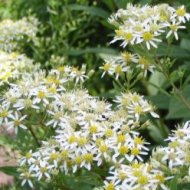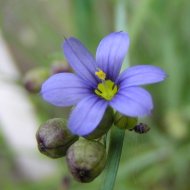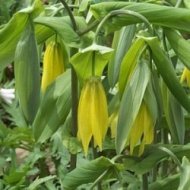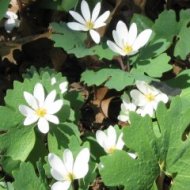by Sandy Garland
 This is an ongoing question among those of us who want to garden in an ecologically sensible way. We aim to plant locally native species based on the argument that locally native insects — as well as mammals, reptiles, amphibians, and other creatures — have evolved with native plants and, therefore, need them to flourish.
This is an ongoing question among those of us who want to garden in an ecologically sensible way. We aim to plant locally native species based on the argument that locally native insects — as well as mammals, reptiles, amphibians, and other creatures — have evolved with native plants and, therefore, need them to flourish.
We see seed packets, plants, trees, etc., labelled native, but we’ve never seen those things growing in the wild. How can we know whether they belong in our ecosystem? Also, if you have access to land outside the city, how can you know which species growing there are really native?
And native to where? If it’s native to the region around Lake Erie, is it okay to plant it here? How will climate change affect what’s native in various places? People are asking these questions and coming up with answers like the following: Why native plants are the better choice for a changing world
The following sources offer more information about plants native to Ontario East and the Outaouais.
Basic resources
 Database of Vascular Plants of Canada (VASCAN)
Database of Vascular Plants of Canada (VASCAN)
This is compiled by scientists who study plants, so it’s very reliable and very extensive. The drawback is that it assigns status by province; for example, a plant whose native range is the Niagara Peninsula will be shown as native to all of Ontario. This list is useful for plants whose taxonomy has changed, as it includes synonyms and previous scientific and common names. Also available in French
Checklist of vascular plants of the Ottawa-Hull region, Canada = Liste des plantes vasculaires de la région d’Ottawa-Hull, Canada
This book, by local botanists John Gillett and David White, was among my first references for checking the status of local plants, so I was delighted to find that it’s now available online. It includes all vascular plants found in a 50-km circle centred on Parliament Hill (the official area of interest of the OFNC). Plant names are given in English, French, and Latin along with a note about how common (or rare) they are. The plants are organized taxonomically, by family, order, etc., but there’s an index at the back, to allow non-botanists to find a specific plant quickly.
 Vascular plants of the city of Ottawa by Dan Brunton
Vascular plants of the city of Ottawa by Dan Brunton
In 2004, Dan Brunton, an ecology consultant and long-time member of the Ottawa Field-Naturalists’ Club, visited every natural area he could find in the Ottawa region and listed all the species found in them. Needless to say, many non-native plant species are on his list, but what an excellent way to tell which are native and which are not.
Plants of Lanark County, Ontario (201o edition)
David White, of “Gillett and White” continued his botanical work after retiring to his home outside Ottawa.
 Ontario Wildflowers
Ontario Wildflowers
An “online field guide” with lots of photos that allows you to search by colour, season, and habitat as well as name. This can be very useful when you find an unknown plant in the wild. However, this database is not complete, and the plant I’m searching for is often missing.
Natural Heritage Information Centre – vascular plants
Maintained by botanist, Mike Oldham, this is the definitive list of vascular plants of Ontario. Some of the information here is highly technical, but scientific and common names are accurate. Important columns include S_RANK, is a code showing how rare or common the plant is in Ontario (range from S5 = very common to S1 = extremely rare); column V (S_RANK_REASON) explains the given rank. Note: this spreadsheet was downloaded in February 2020; for the lastest version, please visit the NHIC web site and scroll down to “species lists.”
Sources of other information about native plants
 Missouri Botanical Garden – the plant finder – growing information and garden uses, as well as potential problems
Missouri Botanical Garden – the plant finder – growing information and garden uses, as well as potential problems
Illinois Wildflowers – an extensive list of species, with descriptions, range and habitat info, and faunal associations
Native Plant Network – protocols for propagating plants from seeds, roots, or cuttings
Sandy Garland is a long-time volunteer at the Fletcher Wildlife Garden. She is very interested in native plants and grows many from seed for the FWG.